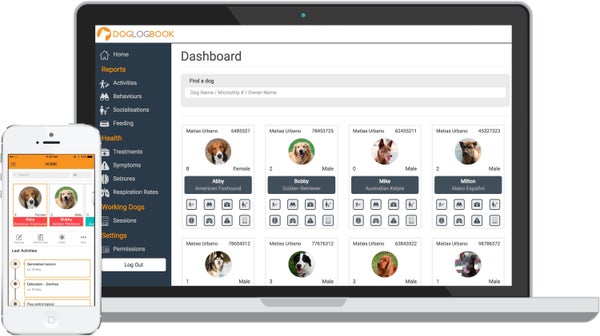This article was published in Scientific American’s former blog network and reflects the views of the author, not necessarily those of Scientific American
While no part of a dog’s life is more important than another, exactly, it’s the bookends — puppyhood and old age — that could use a bit more care and attention.
Enter Doglogbook (Facebook & Twitter), a free app to measure and optimize dog well-being. The app comes from animal welfare researchers and veterinarians at the University of Sydney in Australia, and allows owners to measure and track their dog’s quality of life from puppyhood through old age. Dog lovers get a continual assessment of their dog’s well-being and can elect to share the information with veterinarians, dog trainers, animal behaviorists, or other family members. Animal welfare researchers will use the citizen science data to help inform education for the next generation of veterinary scientists.
Catalyst, Australia's flagship weekly science program, checked out doglogbook in a recent two-part special, “Making Dogs Happy.”
On supporting science journalism
If you're enjoying this article, consider supporting our award-winning journalism by subscribing. By purchasing a subscription you are helping to ensure the future of impactful stories about the discoveries and ideas shaping our world today.
Doglogbook allows owners to track dog activities and behaviors and rate dog enjoyment. An important strategy when assessing quality of life is to look at changes in activities the dog seems to enjoy. The app also tracks behavioral incidents involving fear, aggression, or other issues, and incidents are further assessed by mediating factors like location of incident, who was present, and what else was involved. From there, the app can reveal whether behavior modification strategies are successful or if a new approach is needed.
I, for one, acknowledge the difficult in holding everything in my head. Sometimes after drinking coffee in the morning, I can't remember if I brushed my teeth — was that today or yesterday? Most days I figure it out. When it comes to assessing something more important — like behavior change in a dog — it can be valuable to make it less muddled: when did the last incident happen? Not since last month, oh, but wait. Wasn’t there that thing two weeks ago… I can see how a tracking app would help.
Owners can also track dog health, including treatments, symptoms and even seizures, and the app can set reminders for routine preventative health care, like parasite control, and remind you when they are due.
Doglogbook has a two-path approach, one geared toward companion dogs and owners, and one for working dogs, like guide dogs and scent detection dogs, that maps training investment against performance outcomes. The end result is both a qualitative and quantitative assessment of how dogs are doing over time, which, as with humans, is always changing.

Credit Doglogbook
Returning to the importance of bookends, one of doglogbook’s benefits is preparing puppies for the environment and lifestyle that awaits them. Numerous studies identify benefits to early life socialization, particularly from 3 to 14 weeks, but also beyond. “Dogs can easily be socialized so they do not display the common behavioral problems that relate to anxiety,” explains Professor Paul McGreevy, one of the app’s creators at the University of Sydney. Doglogbook can “[guide] owners as they socialize their pups, making pups more worldly and potentially even saving their lives.”
Early life socialization aims to help normalize the weird world of sights, sounds, people, and places that dogs can encounter. The app is gamified, and owners are rewarded for seeking out and tracking their young dog’s experiences. “This feature,” Doglogbook developers explain, “can work well in conjunction with puppy preschool, or as a simple means of logging when a puppy has travelled, visited different types of environments and meet a range of people and other animals.”
When it comes to end of life decisions — the other end of the bookend — doglogbook’s value increases tenfold, in my opinion. End-of-life decisions are tough (how understated is that?), but with an app tracking well-being, it can be easier to let the dog do the talking. As dogs get older, they can show signs of normal aging, “cognitive deterioration that does not affect the day-to-day functioning of the individual,” or something more serious like canine cognitive dysfunction, where dogs experience “disorientation, altered interactions with people or other pets, sleep-wake cycle alterations, house soiling, and altered activity level.”
Quality of life assessments can highlight where a dog continues to thrive and derive enjoyment and areas where enjoyment is long gone. The ongoing tracking of health symptoms can flag anomalies or a slow decline that might be easily missed, and the app even has a special section on seizures. The resources within doglogbook prioritize dog well-being till the end. Good, doglogbook. Good.
Mia Cobb — my partner in crime at Do You Believe in Dog? (Facebook & Twitter) — and one of the doglogbook developers, describes the benefit of gathering and reviewing data on dog happiness: “Having used this app with my own young dog [Rudy] during beta testing before the global launch, it not only made looking out for his routine healthcare, or sharing his behaviors between vet consultations much easier, it has made me more mindful of what activities Rudy most enjoys. If the app can help owners consider that on a regular basis, or even prompt change in their own behavior to help their dog spend more time each week doing its favorite things, then the whole doglogbook team will feel happy that we’ve achieved our goal of helping dogs live better lives.”
Doglogbook is available for free download from iTunes and Google App stores. To get social: Facebook, Twitter and Contact.
References
